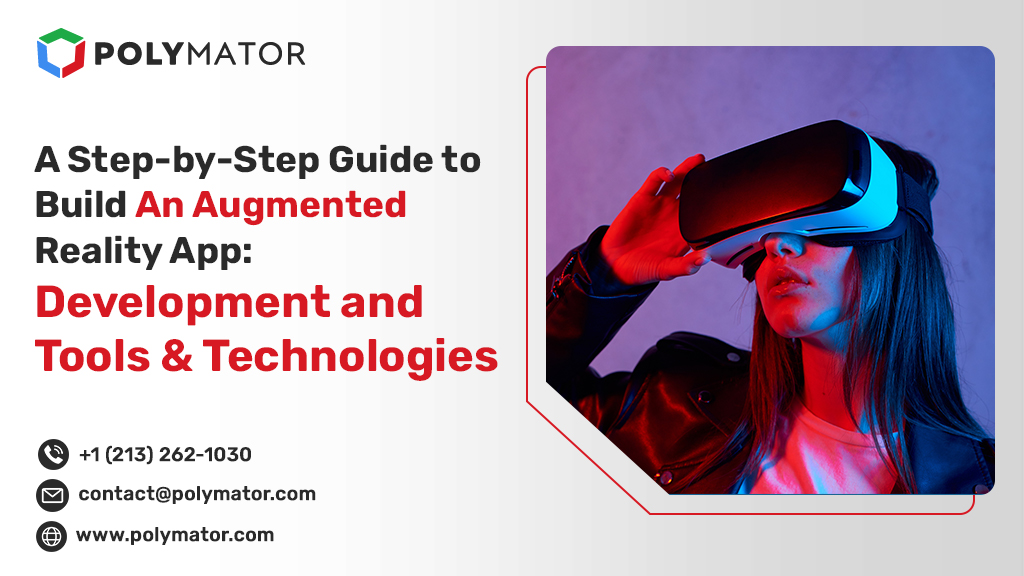Augmented Reality (AR) is a thriving technology transforming the world of software applications. It integrates digital visual content into the user’s real-world environment. Whether it is online gaming or online shopping and even development and learning, augmented reality app development redefines the user experience.
With the evolving technologies available in the digital world, AR is going to play a major role. However, augmented reality setup bridges computer-generated perceptual information to the real world. This allows users to experience comprehensive insights into the potential of AR while using the app.
In this article, we’ll dive into understanding the augmented reality app development process, tools and technologies, and its challenges.
How to Create An AR App? Let’s Explore the Development Process
The market zone for augmented reality is growing dramatically. Check out the step-by-step process of how to make an AR app!
1. Conceptualization and Planning
Firstly, you have to be clear with your concept to build an augmented reality app. Before diving into development, define the objectives of your AR app. Be clear with the experience you’re seeking to provide or the problems you’re trying to solve.
Secondly, conduct a study to identify your target audience and their preferences. Create an AR app that meets the desires of your users and offers them the best experience ever.
Thirdly, list the functionalities and features you ought to provide via augmented reality app development. Platform selections play a vital role here! Whether your AR app will support iOS, Android, or cross-platform? The decision you make will assist you in determining the targeted audience.
Lastly, set your timelines and budget to create AR app, including development expenses, advertising costs, and potential post-launch updates.
2. Design and UI Considerations
The design and user interface (UI) take the centre after your concept is crystallised. Design & UI are more than simply aesthetics; it’s also about creating a user experience that’s exciting and engaging. The following considerations are essential:
- Storyboarding: Map out the user’s journey to ensure a seamless experience and engagement on how users will interact with your AR app.
- UI/UX design: Attest the elements that will integrate with the real world. Also, check the navigation of users throughout the app.
- 3D modelling and animation: Hire a 3D art services and animation company to bring your AR content to life with the help of skilled designers.
- Responsiveness: After the successful augmented reality app development, it is crucial to check resolutions, screen sizes, and responsiveness.
3. Development and Coding
Turn your conceptualization into a fully functional AR app. By choosing the right development tools or augmented reality app development service provider, your dream will come true. The process of development is completed in the following ways:
- AR development frameworks: Ensure to opt for AR development frameworks that comply with your platform and project needs. A few popular choices include platform options like Unity or Unreal.
Read more about Unity vs Unreal: What to Choose for Your Game?
- Integration of AR elements: This step involves integrating and rendering coding to ensure that the AR app responds perfectly to real-world environments.
- Backend development: This includes offering cloud-based services, data handling, server functionality, content delivery, creation of essential cookies, and much more.
- Optimization: Optimise the efficiency and results of your AR app by checking smooth rendering on several devices, maximising 3D assets, and reducing overall loading time.
- Iterative testing: To get a bug-free and robust AR app it requires frequent testing. However, iterative testing ensures that issues are promptly identified and resolved.
4. Testing and Quality Assurance
After the successful creation of the augmented reality app development following tests are performed to polish the delivery of the AR app.
- Functional testing
- Compatibility testing
- Performance testing
- User Acceptance Testing (UAT)
- Bug fixes and optimization
Do note that to build augmented reality apps successfully, thorough testing is required. Enhance the smooth operation and joyful experiences by performing several testing and quality assurance steps on your AR app.
Which are the Tools and Technologies Used to Create AR Apps?
To build augmented reality apps necessitates combining state-of-the-art techniques and technology to smoothly integrate digital content into the real world. Let’s take a look at the tools and technologies for creating AR applications:
1. AR Development Frameworks
Referred to as the backbone for augmented reality app development. It provides essential elements and tools where integrating digital content with the real world becomes easier. A few of the top AR development frameworks are:
- ARKit (iOS): It empowers iOS developers to facilitate features like light reflections, surrounding detail collections, and motion tracking while developing AR apps for iPhones and iPads.
- ARCore (Android): Google’s ARCore is the android part of ARKit. Enabling developers to leverage features while developing AR apps for Android.
- Unity 3D: It is a cross-platform game engine used widely for AR development i.e. supporting both ARKit and ARCore.
- Unreal Engine: Created by Epic Games in 1988, it offers game developers to work on any platform (both iOS and Android) for successful augmented reality app development.
2. Programming Languages
Choosing the right programming language is essential to create an AR app with the best functionality. Some of the key languages are listed below:
- Swift (iOS)
- Java/Kotlin (Android)
- C# (Unity)
- C++ (Unreal)
- Java
- JavaScript
3. 3D Modelling and Animation Software
An engaging augmented reality experience requires the creation of realistic and intriguing 3D models and animations. A number of software programs support this creative element:
- Blender: Widely used for sculpting, modelling, animating, and rendering 3D content for AR applications.
- Autodesk Maya: A renowned software that helps in creating 3D animations and intricate 3D models to introduce visual content into the real world flawlessly.
- Cinema 4D: Create visually appealing and aesthetic 3D elements in AR applications to enhance user experience.
Bottom Line
Navigating intricate elements of augmented reality app development requires cutting-edge creativity, planning, and tools and technologies. With this strategic blend, developers can deliver immersive AR experiences that captivate the needs of users.
Till now, you would have explored “How to create an augmented reality app”! If you still have doubts, then do not hesitate to hire an augmented reality development service provider. If you’re looking for one for your project, then Polymator is your go-to-partner to create an alluring AR app.







